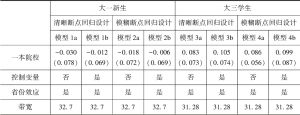章节
推迟的生育?高等教育水平分层与大学生的生育计划
摘要
以往关于教育如何影响生育的研究大多注重教育“量”的维度,缺少对教育“质”的关注。本研究引入教育水平分层的视角,考察不同类型的大学教育是否对年轻世代的生育计划产生影响。本研究将高考作为自然实验,采用模糊断点回归设计的因果分析工具,比较了一本院校和二本院校大学生生育计划的差异。研究结果表明,更为优质的院校对大学生是否有明确的生育计划不存在影响,但会显著推迟他们的理想生育年龄(约1年)。尽管这种推迟作用仅在高年级学生身上有所体现,但研究并未发现性别差异。研究结果显示,优质的教育资源并不会影响学生生育计划的明确性,但会推迟他们的理想生育年龄。
作者
杜世超 ,复旦大学社会发展与公共政策学院社会学系青年副研究员。
检索正文关键字
章节目录
- 一 引言
-
二 文献综述
- (一)教育与生育
- (二)高等教育的水平分层与生育计划
- (三)教育与生育计划的内生性关系
- (四)异质性:年级与性别的影响
-
三 数据、测量与方法
- (一)因变量
- (二)自变量
- (三)控制变量
- (四)分析策略
- (五)效果异质性的分析策略
-
四 结果与统计
- (一)描述性统计
- (二)断点回归估计结果
- (三)稳健性检验
- 五 结论与讨论
查看更多>>>













